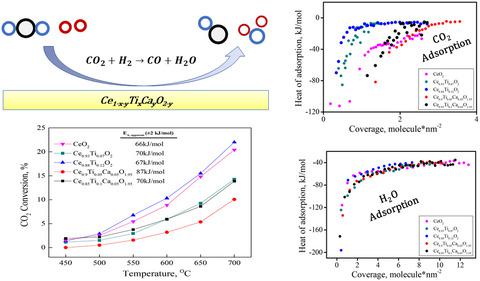当前位置:
X-MOL 学术
›
J. Am. Ceram. Soc.
›
论文详情
Our official English website, www.x-mol.net, welcomes your
feedback! (Note: you will need to create a separate account there.)
Surface properties of Ca, Ti‐doped CeO2 and their influence on the reverse water‐gas shift reaction
Journal of the American Ceramic Society ( IF 3.5 ) Pub Date : 2020-12-19 , DOI: 10.1111/jace.17623 Yuval Mordekovitz 1 , Lee Shelly 1 , Brian A. Rosen 2 , Shmuel Hayun 1
Journal of the American Ceramic Society ( IF 3.5 ) Pub Date : 2020-12-19 , DOI: 10.1111/jace.17623 Yuval Mordekovitz 1 , Lee Shelly 1 , Brian A. Rosen 2 , Shmuel Hayun 1
Affiliation

|
CeO2‐based materials can be found in a variety of catalytic processes, including the reverse water‐gas shift (RWGS) reaction. Nevertheless, the interaction of molecular gases with the surfaces of such materials is still not clear. Recently, some progress was reported on the incorporation of neodymium (Nd) and calcium (Ca) into ceria and their effect on H2O and CO2 adsorption. Titanium (Ti), which has a much smaller ionic radius, has the ability to change the interaction landscape, both as a co‐dopant to Ca and as a sole dopant in the CeO2 system. In this study, the interactions of environmental gases (i.e., water vapor and CO2) on the surface of Ti‐doped CeO2 and Ca,Ti co‐doped CeO2 were investigated. Ti addition to CeO2 was shown to decrease water vapor uptake by up to 25% all while maintaining similar heats of adsorption. In the case of CO2 adsorption, Ti addition to CeO2 had lowered the uptake by more than 50% as well as lowering the heat of adsorption. Co‐doping with Ti and Ca showed small decrease in H2O uptake accompanied with increased heat of adsorption. For CO2, the changes to the uptake and energetics were small and did not indicate a specific trend. The RWGS catalytic performance showed improvement by the addition of Ti in certain levels. The relationship between the doping, surface properties, gas‐surface interactions, and catalytic performance is discussed.
中文翻译:

Ca,Ti掺杂的CeO2的表面性质及其对水煤气逆反应的影响
基于CeO 2的材料可用于多种催化过程中,包括反向水煤气变换(RWGS)反应。然而,分子气体与这种材料的表面之间的相互作用仍然不清楚。近来,关于将钕(Nd)和钙(Ca)掺入二氧化铈及其对H 2 O和CO 2吸附的影响,已有一些进展的报道。钛(Ti)的离子半径小得多,它既可以作为Ca的共掺杂剂,又可以作为CeO 2系统中的唯一掺杂剂来改变相互作用的态势。在这项研究中,环境气体(即水蒸气和CO 2)在Ti掺杂的CeO 2和Ca,Ti共掺杂的CeO的表面上的相互作用调查了2个。已表明,向CeO 2中添加Ti最多可将水蒸气吸收量降低25%,同时保持相似的吸附热。在CO 2吸附的情况下,向CeO 2中添加Ti可使吸收率降低50%以上,并且降低了吸附热。与Ti和Ca的共掺杂显示H 2 O吸收量略有下降,同时吸附热增加。对于CO 2,吸收和能量的变化很小,没有表明特定的趋势。通过添加一定量的Ti,RWGS的催化性能得到了改善。讨论了掺杂,表面性质,气体-表面相互作用和催化性能之间的关系。
更新日期:2020-12-19
中文翻译:

Ca,Ti掺杂的CeO2的表面性质及其对水煤气逆反应的影响
基于CeO 2的材料可用于多种催化过程中,包括反向水煤气变换(RWGS)反应。然而,分子气体与这种材料的表面之间的相互作用仍然不清楚。近来,关于将钕(Nd)和钙(Ca)掺入二氧化铈及其对H 2 O和CO 2吸附的影响,已有一些进展的报道。钛(Ti)的离子半径小得多,它既可以作为Ca的共掺杂剂,又可以作为CeO 2系统中的唯一掺杂剂来改变相互作用的态势。在这项研究中,环境气体(即水蒸气和CO 2)在Ti掺杂的CeO 2和Ca,Ti共掺杂的CeO的表面上的相互作用调查了2个。已表明,向CeO 2中添加Ti最多可将水蒸气吸收量降低25%,同时保持相似的吸附热。在CO 2吸附的情况下,向CeO 2中添加Ti可使吸收率降低50%以上,并且降低了吸附热。与Ti和Ca的共掺杂显示H 2 O吸收量略有下降,同时吸附热增加。对于CO 2,吸收和能量的变化很小,没有表明特定的趋势。通过添加一定量的Ti,RWGS的催化性能得到了改善。讨论了掺杂,表面性质,气体-表面相互作用和催化性能之间的关系。











































 京公网安备 11010802027423号
京公网安备 11010802027423号